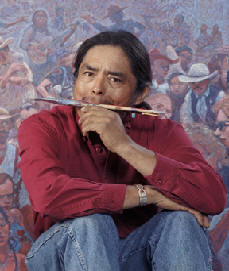I am sitting across the booth from Tony Norris at Brandy’s restaurant. It is still early for breakfast, but late enough so we can talk without disturbing the patrons. Except for the clinkings of dishes and utensils, it is a good place for our hushed conversation. This is new for me. Usually I am the one being interviewed. This is also Tony’s brainstorm. He says that our audience knows our words and the pictures we paint, but they need to know who we are. So the idea of picking each other’s brains to expose our journey thus far, was given birth.
I met the man some years ago while he and my good friend Clarence Clearwater were both working on the Grand Canyon Railway. Tony in his 50-gallon Stetson and wild west outfit certainly looked the part. Each time I have seen him on the street or on a stage, he was in character. I often wondered, “Who is the man beneath the wide-brimmed cowboy hat?” He wears a smaller hat today. His joviality and thoughtful answers come across the table clearly. It isn’t so much an interview as it is just two buddies having breakfast and talking about the past.
As a Dineh protocol, I ask him first what his clans are, his European forebears. “Oh, I’m just a mixture of all kind,” he drawls. “Mostly Scotch-Irish with a dose of English and maybe German.”
I mull this over and declare he is a member of the Potato Clan (Irish), Metalhead Clan (German) and the Skirt-and-Nothing-More Clan (Scottish). The-Hard-To-Hear Clan (French) he is not a member of. “Sin ne’ nilli’ Ba ho zhoni” is a Dine Native name which comes to me that would suit him well. (The Kokopelli of music, mirth and stories in happiness).
“I would tell you about my native blood, unfortunately I do not have any great records of this lineage,” he muses. “My maternal grandmother is full-blooded Cherokee. That is all I know.” Another Cherokee-princess-gone-wild story, I think to myself. Tony knows all too well how many Anglos are actually descendants of them Cherokees. Our laughter validates him.
Tony and his wife Sue’s granddaughter is half Dineh. Nizhoni’ Shundiin’ is her name: Beautiful Rays of Sunlight. Nizhoni’ is 12 and just a ray of sunlight for the family. Tony shares with me some memories of meeting the father’s clan elders and how they made a deep impression on him. “How many ponies will you give me?” Tony teased. The young man’s response was the right one: “As many as it takes.” Upon leaving, great-grandma wanted to know, “Is he serious about the horses?” Tony’s eyes twinkle as he relates this.
I cannot help but feel kinship to this wonderfully rotund and gentle soul. “I believe that each of us are given a choice each day we breathe to either build community or tear it down,” he says. Here is a man who brings communities together through his art. His gigs all over this town to attest to that fact. This is a man who knows the power of that gift and passes it on to others. “I choose inclusion rather than exclusion as a rule of thumb,” he says.
“For some reason, I am under the impression that you lived in a hippie commune,” I query.
“You could call it that,” Tony answers. “Although it was more of a commune with structure and based in green ideas.”
This place called School of Living is where he started his musical journey. He was in his late teens and stout. Tony met his beautiful wife Sue there north of Baltimore in the late ’60s and eventually sired three daughters and two sons. He came from a family of eight brothers and three sisters. This sounded so familiar. I do not know many Texans besides my sister and her family in Irving. Now, here is Tony who was born in Aledo, Texas, in 1950.
Spending time with Tony is time spent well. I get to know the man beneath the hat. A fellow writer. A drinking man with a guitar problem.

